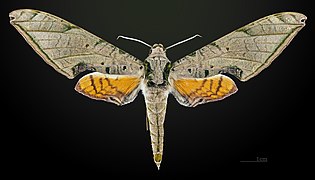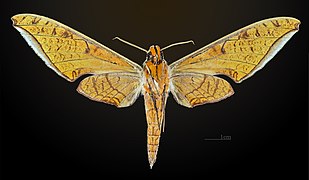Protambulyx strigilis
| Protambulyx strigilis | ||||||||||||
|---|---|---|---|---|---|---|---|---|---|---|---|---|

Protambulyx strigilis |
||||||||||||
| Systematics | ||||||||||||
|
||||||||||||
| Scientific name | ||||||||||||
| Protambulyx strigilis | ||||||||||||
| ( Linnaeus , 1771) |
Protambulyx strigilis is a butterfly ( moth ) from the family of moth (Sphingidae).
features
The moths have a fore wing length of 48 to 55 millimeters and reach a wingspan of 108 to 134 millimeters. Due to its size, its predominantly orange basic color and the elongated fore wings, the species can be easily distinguished from the other swarmers in southern Florida. It is similar in body size and wing shape to Adhemarius blanchardorum , which occurs in Texas on Big Bend , but whose wings have a strongly concave outer edge of the forewing and also a very large dark spot near the base on the inner edge of the forewing. Protambulyx strigilis is very variable in its coloration, which also gave rise to problems regarding species delimitation over the duration of the research. The basic color of both pairs of wings varies from brick red to pale yellow. The front wings can be almost unpatterned, but they can also have a clear pattern along the costal and outer edge as well as at the anal angle or these features in all conceivable combinations. The hind wings are similarly variable in color and orange-brown in the darker form. The top of the hind wings of both forms is patterned with irregular, sloping lines and a clear submarginal line and has a pale outer edge. The forewing inner edge is indented. A clear submargin line and a dark band along the indentation on the inner edge are formed.
The caterpillars have the typical build of the subfamily Smerinthinae with an elongated, thin body that tapers towards the head.
The doll is dark brown and has a somewhat rough surface. The proboscis cannot be seen. The cremaster is very wide and ends in a single, sharp point.
Occurrence
The species is distributed in the tropical and subtropical lowlands in large parts of Central and South America and is native to Mexico, Belize, Guatemala, Honduras, Nicaragua, Costa Rica, Panama, the West Indies, south to Colombia ( Meta ), as well as in Ecuador, Detected in Peru ( Junín and possibly also in the east), Bolivia ( Santa Cruz ), Venezuela, Guyana, Suriname, French Guiana, Brazil ( Minas Gerais ) and Argentina ( Salta ).
In North America, the species only reproduces in the southern half of Florida. It occurs mainly in the southern counties and is evidently common where its most important host plant, Schinus terebinthifolia , is planted. However, this knowledge could also be caused by selective caterpillar collection on these plants. It is certain, however, that the species expands its range strongly to the north. The host plant introduced into Florida is very invasive and spreads rapidly, making the hawk species increasingly common, especially along the Gulf Coast, at least as far as the Tampa Bay area . For example, the species was detected when visiting flowers on Sanibel Island as early as the 1960s and 1970s, but caterpillars were not discovered for a long time. In the meantime, however, the species has also been established here and caterpillars are regularly found. Outside Florida, the species was observed north of Mexico only once in 1972 in Galveston County , Texas.
Way of life
The adults can be observed regularly at artificial light sources. They are mostly active at dusk and have been observed sucking nectar on Asystasia gangetica (introduced), jasmine, and rose catharanthe ( Vinca rosea ) in the United States .
Flight and caterpillar times
The species reproduces in southern Florida all year round, so moths can be found all year round. In Costa Rica, the moths are also found every month of the year, although they are much rarer in December and March. In Bolivia they fly from April to August and from October to December.
Food of the caterpillars
In the United States, in addition to Schinus terebinthifolia , the caterpillars were also found on Metopium toxiferum , both of the sumac family (Anacardiaceae). In addition, the crawler to the Sumachgewächsen are Spondias dulcis , Spondias mombin , Spondias purpurea , Astronium graveolens , Anacardium occidentale , Erythroxylon , Comocladia Dodonea and Comocladia dentata and to the bitter ash plants (Simaroubaceae) Simarouba glauca and Simarouba amara detected. Other food plants are Erythroxylum havanense , Eupatorium villosum , Lycopersicon and Sambucus australis .
development
The females lay their eggs individually on both sides of the mature leaves of the food plants. The eggs are large in relation to the size of the moths. Accordingly, females can usually only lay fewer than 60 eggs. The caterpillars hide on the underside of the leaves along the midrib. Because of their coloring, they are well camouflaged there. Pupation takes place in a loosely spun cocoon just below the soil surface. Larger caterpillars hide at the base of the leaves or near the base of the plant stem during dormant periods. As parasitoids are tracked flies of the genus Drino known.
Taxonomy and systematics
As early as 1903 when Rotschild & Jordan described the species Protambulyx carteri on the basis of differences to Protambulyx strigilis in the pattern of the forewings , it was unclear whether it was actually a separate species. In 1971 Hodges found that the two "species" did not differ genitally morphologically, but retained the species status for both species. Tuttle established through breeding that the two "species" are color morphs of one and the same species. This has been confirmed by the fact that light-colored, weakly patterned moths occur in the dry forests of the Guanacaste National Park in Costa Rica and dark, strongly patterned moths ("strigilis") originate from the higher-lying moist forests. In his opinion, it is therefore a matter of color differences caused by external influences in the living space. Since Protambulyx strigilis has priority because of the earlier description, Protambulyx carteri was synonymous with this species by Tuttle. In 2008, however, Heppner restored the taxon to the rank of an independent species.
supporting documents
Individual evidence
- ↑ a b c d e f g h i j James P. Tuttle: The Hawkmoths of North America, A Natural History Study of the Sphingidae of the United States and Canada. The Wedge Entomological Research Foundation, Washington, DC 2007, ISBN 978-0-9796633-0-7 .
- ↑ a b c d e f Sphingidae of the Americas. Bill Oehlke, accessed June 21, 2013 .
- ↑ Protambulyx carteri Rothschild & Jordan, 1903. Sphingidae Taxonomic Inventory, accessed July 1, 2015 .
literature
- James P. Tuttle: The Hawkmoths of North America, A Natural History Study of the Sphingidae of the United States and Canada. The Wedge Entomological Research Foundation, Washington, DC 2007, ISBN 978-0-9796633-0-7 .



